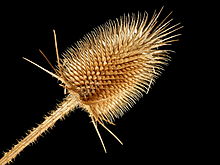- Dipsacus laciniatus
-
Dipsacus laciniatus 
Scientific classification Kingdom: Plantae (unranked): Angiosperms (unranked): Eudicots (unranked): Asterids Order: Dipsacales Family: Dipsacaceae Genus: Dipsacus Species: D. laciniatus Binomial name Dipsacus laciniatus
L.Dipsacus laciniatus is a species of flowering plant in the teasel family known by the common name cutleaf teasel. It is native to Europe and Asia. It is present in North America as an introduced species and invasive weed.[1]
This plant is a perennial herb that may grow up to 2 to 3 meters in height. The erect, branching stem is hollow and prickly. The leaves are oppositely arranged, each leaf pair joined around the stem and clasping it, their bases forming a cup which often collects water. The species is monocarpic, living for multiple years but only flowering once before dying. The inflorescence is an egg-shaped head subtended by long bracts. The head may contain up to 1500 flowers. Blooming lasts one day. The middle of the head blooms first and then the upper and lower parts. The fruit is an achene just under a centimeter long.[2] The plant reproduces only by seed.[3] This teasel may be distinguished from its relative, common teasel (Dipsacus fullonum) by flower color and leaf shape. Cutleaf teasel has white flowers and deeply cut leaves, while common teasel has purple flowers and toothed or wavy-edged leaves.[2]
Cutleaf teasel is a weed in the United States, where it is most prevalent in the Midwest and northeastern states. It has been known in New York and Michigan since before 1900. It is now a dominant species in some areas, such as a tallgrass prairie in Illinois. It grows in a variety of habitat types, and does best on good soil; individuals growing on fertile soil reach large, robust sizes. The plants can also tolerate saline soils.[2]
The mite Leipothrix dipsacivagus is being investigated as a possible agent of biological pest control for this plant.[4]
References
- ^ Dipsacus laciniatus. Germplasm Resources Information System.
- ^ a b c Gucker, Corey L. 2009. Dipsacus fullonum and D. laciniatus. In: Fire Effects Information System, [Online]. U.S. Department of Agriculture, Forest Service, Rocky Mountain Research Station, Fire Sciences Laboratory.
- ^ Bentivegna, D. J. and R. J. Smeda. (2011). Cutleaf teasel (Dipsacus laciniatus): Seed development and persistence. Invasive Plant Science and Management. 4(1) 31-37.
- ^ Pecinar, I., et al. 2008. Morphological injury to cut-leaf teasel, Dipsacus laciniatus L. (Dipsacaceae) induced by the eriophyid mite Leipothrix dipsacivagus Petanovic et Rector (Acari: Eriophyoidea). Journal of Plant Interactions. 4:1-6
External links
Categories:- Dipsacaceae
- Invasive plant species
Wikimedia Foundation. 2010.
